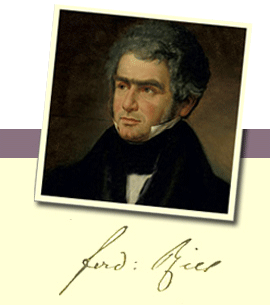RIES JOURNAL
RIES JOURNAL Ausgabe 8/2025

In music history, masterpieces such as the Ninth Symphony are usually only researched with regard to their authors. The fact that other people were always indispensable for its production and its path to the public is often overlooked. This was also the case with the Ninth Symphony, for which Beethoven's pupil, friend and fellow musician Ferdinand Ries played a central role in its commission by the London Philharmonic Society and its first performance in the Prussian Rhineland in Aachen in 1825. In this essay, the Bonn musicologist Beate Angelika Kraus, who published the scholarly edition of the Ninth as part of the Beethoven Complete Edition in 2020, reverses the perspective and describes the complex genesis of this symphony for the first time from the perspective of the person who had spent eight years in London on the board of the Philharmonic Society, campaigning for Beethoven to be commissioned to compose a new major symphony for the Society. […]
The focus of Beate Angelika Kraus's essay is a music-historical micro-analysis of the early performance history of the Ninth Symphony in the two middle chapters, which are dedicated to its performance at the 8th Lower Rhine Music Festival in Aachen in May 1825. The fact that Ries, who was then at the zenith of his fame, had returned to Godesberg near Bonn in mid-1824 prompted the Aachen committee to approach him at the end of the year and offer him the directorship and organisation of the first Lower Rhine Music Festival to be held in Aachen. […]
The Lower Rhine Music Festivals were mass concerts – the two-day event in Aachen involved 423 musicians from different places and of different levels of ability in the choir and orchestra. […]
As the sheet music for the Ninth Symphony was not yet available in print, Ries had to obtain originals from Beethoven and have them copied for the 147 musicians in the orchestra and the 266 choral singers. Beethoven's typical tardiness in delivering the music meant that Ries only had half the score two months before the concert date and nothing at all of the orchestral parts five weeks before the performance. In view of these circumstances, he considered a performance of the entire Ninth Symphony to be an ‘extremely dangerous matter’ just one month before the concert, as the work was not only hugely complicated and correspondingly difficult to play, but only two full rehearsals were possible, as the choirs and orchestra gathered in Aachen only two days before the performance. To avoid the risk of failure, it was agreed to perform the symphony in a shortened version. Only the first movement, a shortened third movement and the fourth movement were performed. According to the author, the fact that Ries "stuck to his project under these circumstances and did not simply put a different and already well-known Beethoven composition on the programme instead of the Ninth Symphony speaks for his ambition and his abilities as a musician and conductor (...).
Two hundred years on, this logistical and artistic achievement still deserves great respect". Despite all the adversities, a mass concert was performed on 23 May 1825 in front of an audience of 1,410, which was new for the time. The unusually large orchestration, with more than twice as many participants as at the Viennese premiere, gave the Ninth Symphony an entirely new dimension. This marked the beginning of a development that was to continue thereafter. More than 690 musicians took part in the performance of the Ninth Symphony at the 23rd Lower Rhine Music Festival in Cologne's Gürzenich Hall in 1841. “It can be said,” the author concludes, “that Ferdinand Ries in Aachen in 1825 was the first to dare to perform a work that was so difficult to interpret with an extremely large orchestra for its time, thus giving it a completely new sound.” […]
You can order the publication from
Ferdinand Ries Gesellschaft, Kaufmannstraße 32,
D-53115 Bonn,
Tel. 0221/519171, info@ferdinand-ries.de
RIES JOURNAL Ausgabe 7/2023
>> PDF-Version der Ausgabe 07-2023
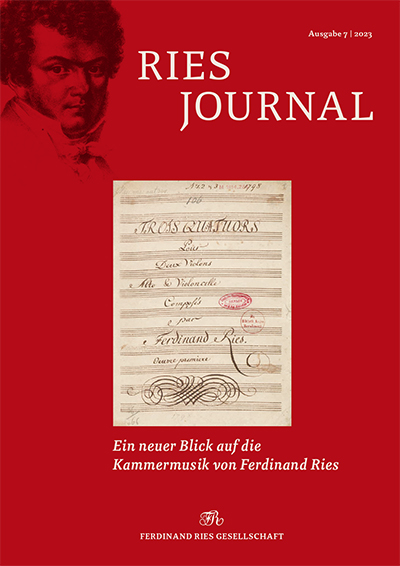
In this issue, musicologist Philipp Leibbrandt summarises his new insights into Ferdinand Ries’ chamber music, which he has researched in an 800-page Ph.D. dissertation submitted to the Ludwig-Maximilians-University in Munich in 2020. Examining Ries’s compositional work from the very beginning in Bonn in 1798 to the last works written in Frankfurt in 1837, the author comes to the conclusion that chamber music in Ries’ work is of particular importance in all creative periods. For the composer, it was the great field of experimentation on which he tirelessly tested new ideas, forms and means of expression and developed his own musical language in dealing with the conventions of the time. In this essay, detailed work analyses alternate with clear descriptions of both the biographical and the music-historical and genre-historical contexts in which the respective works, from the trio to the octet, were created. It becomes clear that the role models for Ries’ early works were primarily Mozart and Haydn, even if the tonal language of Beethoven, in whose immediate vicinity Ries lived and worked from 1803 to 1805, rubbed off on his early string quartets. […]
Leibbrandt emphasises the years 1813 to 1824, when Ries was one of the directors of the recently founded Philharmonic Society in London, as defining for Ferdinand Ries’ individual use of forms in his chamber music. In the booming music metropolis of London, Ries not only turned to composing symphonic works for the first time, it was also here that he developed a new format for large-scale chamber music works with piano, such as the Sextets, Op. 142 and Op. 100, the Piano Quintet, Op. 74, the Piano Quartet, Op. 129 and the Octet, Op. 128, works which Leibbrandt describes as “chamber music for the stage” in contrast to conventional intimate chamber music. Inspired by the new performance opportunities offered by the Philharmonic Society, Ries became with these works one of the main initiators of the preference for such concertante chamber music works that emerged in the early 19th century. In the last chapter of his essay, Leibbrandt shows that chamber music for Ries continued to play an important role as an experimental field for innovations after his return to the Rhineland in 1824. During this time it was mainly the genres for strings in which the composer was looking for new ways, forms and ideas, and in doing so he “came to astonishing and unusual solutions”, solutions that the “new” group of composers born around 1810 like Chopin, Liszt, Schumann or Mendelssohn could build upon.[…]
In order to raise public awareness of the chamber music works of Ferdinand Ries, our society has offered in 2020 the FERDINAND RIES PRIZE as part of the international Chamber Music Competition for Historical Performance Practice “Beethoven in his time” (“Beethoven in seiner Zeit”) in Siegburg. On 30 May 2021, the TRIO EGMONT was awarded the prize for the best interpretation of a work by Ferdinand Ries, for which 35 ensembles with 76 young musicians competed. The Trio Egmont was founded in 2019 by violinist Luiza Labouriau, cellist Martin Knörzer and pianist Gilad Katznelson. By the end of this year the Trio Egmont will release a CD with three chamber music works by Ferdinand Ries on the Naxos label. These are Op. 2 (Bonn 1807), Op. 143 (Godesberg 1826), and WoO 86 (Frankfurt 1836).
RIES JOURNAL Special Edition 6/2020
>> PDF-Version der Ausgabe 06-2020
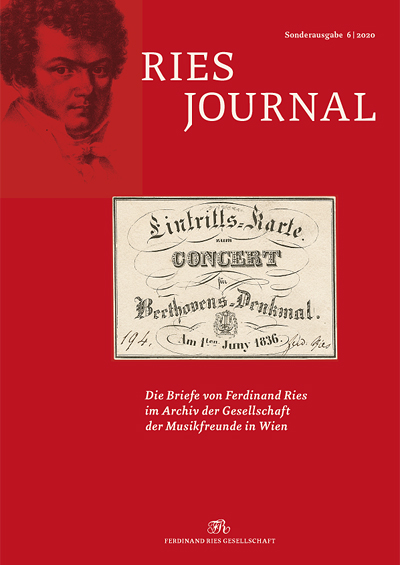
In the recently published Special Edition of the RIES JOURNAL Prof. Dr. Ingrid Fuchs, Vice Director of the Gesellschaft der Musikfreunde in Vienna, introduces to us an important bundle of hitherto unpublished letters by Ferdinand Ries.
The 14 letters are located in the archives of the Gesellschaft der Musikfreunde in Wien, one of the oldest surviving and most renowned music societies worldwide. The letters written in the years from1808 to 1837 are addressed to the music publishers Kühnel, Schlesinger, Peters and Nägeli, to leading members of the Philharmonic Society of London and the Gesellschaft der Musikfreunde in Wien, as well as to the composer friends Ignaz Moscheles and Carl Czerny. In the earliest letter 24-years old Ries approaches the Leipzig Bureau de Musique, offering no less than nineteen works for publication. The most recent letter from 1837, acknowledging the appointment as honorary member of the Gesellschaft der Musikfreunde in Wien, testifies to Ries' high standing in the musical world of his time.
The second part of Professor Fuchs‘ contribution is devoted to the 1836 concert in Frankfurt am Main which was mounted to the benefit of the erection of the Beethoven monument in Bonn. Starting from the presentation of the sole known ticket of entrance to this concert, likewise held in the archives of the Gesellschaft der Musikfreunde in Wien, the event is discussed in thorough detail, including extensive rendition of contemporary press reports and other sources.
Bisher erschienen: RIES JOURNAL Doppelnummer 05/2018
>> PDF-Version der Ausgabe 05-2018
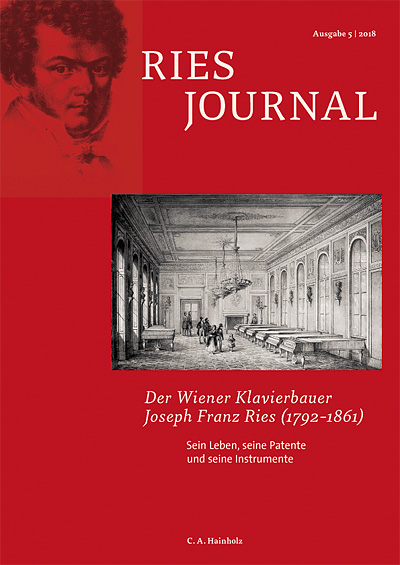
In the fifth number of the RIES JOURNAL you are presented with the life and work of Franz Joseph Ries (1792 – 1861), Ferdinand Ries‘s third brother, a passionate maker of pianofortes.
The US-based German musicologist Sabine K. Klaus has kindly permitted us to publish here, for the first time in German, her article on Joseph Franz Ries which had previously been printed in 2003 in the Early Keyboard Journal, no. 21. Her study depicts the difficult life of a pianoforte manufacturer in mid-19th century Vienna when there was much demand of pianos, but equally large competition amongst piano manufacturers.
Viennese music historian Rita Steblin has found numerous hitherto unknown biographical details on Joseph Franz Ries in the local archives complementing the portrait drawn by Sabine K. Klaus. As Rita Steblin‘s text is written in easily comprehensible English and all available documents are given in the German original, the editors have followed her suggestion and go without a German translation, as the current issue is already rather voluminous through the publication of the two texts.
Ferdinand Ries‘s music is met in recent times with growing interest also by the younger generation of musicologists both from Germany and abroad. Klaus Wolfgang Niemöller gives a cumulative review of three interesting Master and Bachelor theses of the past two years.
Bisher erschienen:
RIES JOURNAL Doppelnummer 04/2016
>> PDF-Version der Ausgabe 04-2016
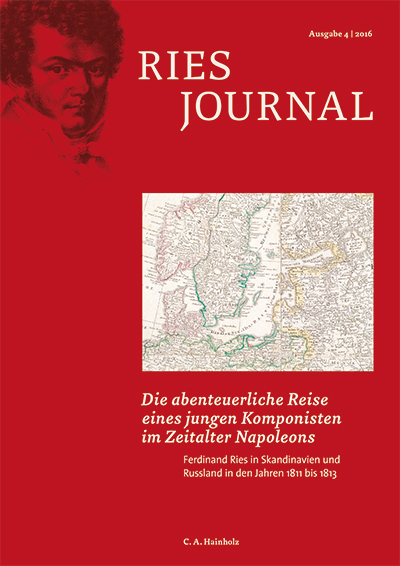
In the volume at hand, Swedish pianist and music historian Anders Gabriel Sundström examines the extensive concert tour undertaken by Ferdinand Ries which, between 1811 and 1813, took him to Northern Germany, Denmark, Sweden, Finland and Russia.
When Ries left Bonn at the end of 1810, he had already built a reputation as a virtuoso pianist and talented young composer during his extended periods of residence in Vienna and Paris. During the tour, which lasted two and a half years and covered almost 8000 km, he matured into an independent and innovative composer.
Until now little was known about this trip other than what we can learn from the small number of surviving letters written by Ries during this time. As he habitually noted date and location in his manuscripts, we are able to reconstruct his itinerary and to capture the wealth of works created during this time. Despite the at times risky events and exhausting travel conditions, the numerous encounters and experiences in strange places must have inspired him to such a degree that he created new works in every city he performed in. Early key works stem from this time such as, for example, his Concerto for Two Horns and Orchestra WoO 19, written in Kassel, as well as his charming Piano Concerto No.3 op. 55 and the „Swedish National Airs“, which secured his election to the Royal Swedish Academy of Music. With these works he established his own style of writing which set him apart from his teacher Beethoven and also from other composers of his generation.
The author has accessed hitherto unknown Swedish and Finnish sources and, above all, used the numerous reports from the Allgemeine Musikalische Zeitung, which paints a lively picture of the development of Ries’ career and the environment in which his music was received in Europe between the years of 1811 and 1813.
As the original text by Anders Gabriel Sundström was written in English and the music of Ferdinand Ries is increasingly getting recognized and admired by an international audience, the board, with this magazine, has taken the decision to publish the RIES JOURNAL for the first time in a bilingual edition (German/English).
Bisher erschienen:
RIES JOURNAL Doppelnummer 03/2014
>> PDF-Version der Ausgabe 03-2014
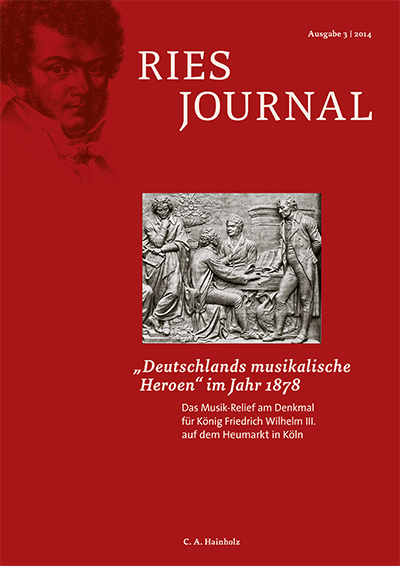
The topic of the 3rd edition of the RIES JOURNAL is a document of the history of musical reception, which, although visible to everybody, has not yet been the subject of music historical research. It is the "music relievo" on the base of the monument to the Prussian King Friedrich Wilhelm III on the Heumarkt in Cologne, which was unveiled in 1878. On this base are depicted seven musicians and composers who were considered to be the most important personalities in the development of music in Prussia and the Rhineland, which was part of Prussia since 1815. It shows, gathered around the central figure of Ludwig van Beethoven, the musicians Carl Maria von Weber, Felix Mendelssohn Bartholdy, Giacomo Meyerbeer, Bernhard Klein, Carl Friedrich Zelter, and Ferdinand Ries.
Barbara Mülhens-Molderings examines the history of the development of the iconographic programme of the music relievo and its artistic realization by the Berlin sculptors Hermann Schievelbein and Alexander Calandrelli, using their previously hardly examined sculptural and graphic designs. Klaus W. Niemöller places the history of the music relievo into a cultural-historical context, relating it to the musical activities, associations and institutions of Cologne's civil society. Also he investigates the relationship between the musicians and composers depicted and Prussia and the Rhineland, and what predestined them for being included in the Rhenish-Prussian pantheon of music in 1878.
RIES JOURNAL Doppelnummer 02/2012
>> PDF-Edition (German) 02-2012
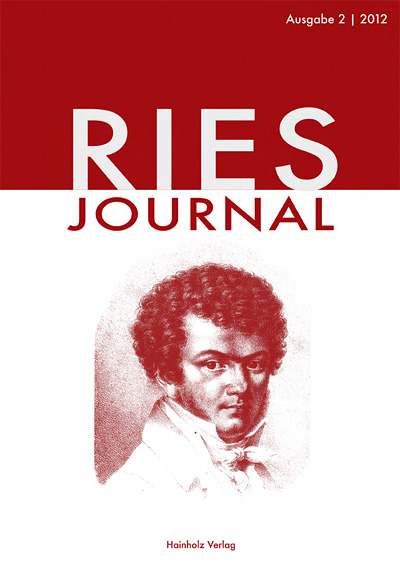
Die 2. Ausgabe des RIES JOURNALS enthält eine umfangreiche quellengeschichtliche Studie von Klaus W. Niemöller zu den Niederrheinischen Musikfesten. Ferdinand Ries bestimmte eine ganze Phase dieser über das Rheinland hinaus wichtigen Großveranstaltungen. Es waren nicht weniger als acht Musikfeste, auf denen er zwischen 1825 und 1837 nicht nur als Festdirigent, sondern auch als Komponist auftrat. Des Weiteren stellt der Autor die rheinische Altertumssammlerin und engagierte Musikfreundin Sibylle Mertens-Schaafhausen vor, zu der Ries in freundschaftlicher Verbindung stand und die eine führende Rolle bei der musikalischen Vorbereitung der Bonner Teilnehmer an den Niederrheinischen Musikfesten in Aachen, Düsseldorf und Köln spielte.
Des Weiteren enthält das Heft einen Beitrag von Axel Beer, in dem der Inhalt von 27 bisher unpublizierten Briefen von Ferdinand Ries an das Bureau de Musique von Ambrosius Kühnel und C. F. Peters in Leipzig in Form eines Überblicks vorgestellt wird.
RIES JOURNAL Doppelnummer 01/2011
>> PDF-Edition (German) 01-2011

Gleich in der ersten Nummer können wir mit einer kleinen Sensation aufwarten: Barbara Mülhens-Molderings – die Vorsitzende der Ferdinand Ries Gesellschaft – hat das Original einer bisher nur in Auszügen bekannten, seit dem Zweiten Weltkrieg als verschollen geltenden Briefs von Ries ausfindig gemacht.
Dieser Brief ist von besonderem Wert, weil er eine autobiographische Skizze und ein Werkverzeichnis enthält. Er wird hier nun erstmals vollständig als Faksimile und in Übertragung veröffentlicht.
Einzelpreis: 4,50 € -, Doppelnummer 6,-- €
ISSN: 2193-4428
Zu bestellen bei:
Ferdinand Ries Gesellschaft e.V. Bonn
Weberstraße 61
53113 Bonn
info@ferdinand-ries.de
|
